
That post-in-progress on Unity of Being in Fantasia and Dumbo? the one that prompted me to mount an informal defense of psychoanalytic thought? – you guessed it, it’s still kicking me in the ass. So I’m going to do a Tristram Shandy and progress by digressing. I’m going to address one of the issues I posed in the antepenultimate paragraph of that post:
When Dumbo is kicked from the burning tower in his second appearance in the circus, he lands in a tub filled with white liquid, not water, but a white liquid. Is that supposed to suggest milk? If so, why?And, just so you know that I’m going somewhere, I’m going to go from that puzzle to what is, after all, the single biggest puzzle in this film: Why a parade of pink elephants?
Before tackling either of those, however, I want to pose a question: What’s the problem? Why think about them – the tub filled with milk, the pink elephants – at all? The obvious answer is: Because they don’t make any sense.
Caveat: this is a long one. You might want to pull up a stool, rest your feet, and get a plate of chips or veggie pieces. This is going to take awhile.
Deliberate Nonsense
Take the pink elephants sequence. It is the best-known sequence in the film. It takes up four and a half minutes of screen time at the beginning of the film’s last quarter, but it doesn’t advance the plot in any direct and obvious way. It tells us nothing about Dumbo, his mother, or the circus. Nothing.
Of course, Dumbo’s physical situation at the end of that sequence is very different from his physical situation at the beginning of that sequence. When the sequence began he was in the middle of the circus grounds getting drunk. When the sequence ends he’s up in a tree out in the country somewhere, with the circus nowhere in sight. And that presents a physical problem that is also dramatic: how is he ever going to get back to the circus? But it’s difficult to see what the sequence itself has to do with however Dumbo got up in that tree. They could have put just about any old thing in there to "cover over" Dumbo's drunken flight.
The sequence looks like it’s just a placeholder. And yet that can’t possibly be so. Animation is a very expensive way to make films. Walt’s bean-counting brother, Roy, wouldn’t have let him waste four-and-a-half minutes of animation resources on a mere placeholder.
No, that sequence is in the film because it is dramatically necessary – something I argue in American Mythology in Disney’s Dumbo.
By this time Walt Disney had been in the animation business for over a decade and a half and had enjoyed over a decade of tremendous success. His story-men, animators, in-betweeners, background artists, inkers, painters, and cameramen were the best in the business. These people knew what they were doing, though their deepest knowledge was, no doubt, more intuitive than explicit. If they put the pink elephants sequence in the film, they did so because it HAD to be there.
For what it’s worth, I’ve come to adopt a rule of thumb that goes something like this:
When competent and experienced artists do something that doesn’t make any sense, pay attention. Precisely because they’re competent and experienced artists they know that whatever-it-is doesn’t make any sense but they do it anyway because that bit of nonsense somehow solves a problem that must be solved.And so it is, in a more modest way, with that white liquid Dumbo dives into. What Dumbo is doing is a familiar gag in cartoons. A character in a circus is high up on a pole and dives, or is pushed, into a small tub of, we presume, water, and does so without injury. It’s always water that the character dives into, at least we assume it’s water. Why? Because it’s transparent, like water. And water is common and ubiquitous, frequently in tubs, and so forth and so on. Water is our default assumption in such cases.
Thus, when Dumbo goes through the net and the liquid flies out as he enters it, the white color comes as a surprise. And the camera holds and zooms in on Dumbo for about ten seconds, forcing that whiteness upon us. We have no choice but to notice it and wonder about it. At the end of that shot there’s a quick cut and we’re watching and listening to the clowns congratulate themselves after that smashing performance. THEY wow’ed ‘em, and poor Dumbo was their foil. We’re into the next sequence in the film.
Before looking at the film in some detail, however, I’d like to build some conceptual equipment.
Coming of Age
Let’s state the obvious: Dumbo is a coming of age story. Instead of an adolescent becoming an adult, or a princess becoming a queen, it’s the story of an infant elephant becoming a somewhat more mature, but still quite young, elephant: a child. This much is obvious, no depth psychology needed to see that.
And it’s a story that’s severely time-compressed. By my count (see HERE) the story takes place over six days. I don’t know anything about the life cycle of real elephants, but I rather doubt that a significant developmental milestone is reached in such a short time. Certainly no human infant passes a major milestone after only seven days.
But why, you might ask, talk about human development when this is a story about elephants? The answer to that is all but self-obvious, but it is worth stating explicitly. The elephants in Dumbo aren’t real elephants, nor, for that matter, are the humans real humans and the lions real lions, etc. They’re all imaginary. More importantly, the logic of this story is more that of myth than that of a realistic depiction of life in a circus.
This is a story created by human beings for viewing by other human beings. It is a story that must, in the end, be comprehended, analyzed, and described in human terms. In human terms this is a story of a child moving from one developmental stage to another.
To recast Dumbo’s predicament in the terms Erik Erikson’s account of psychological growth (The Life Cycle Completed, 1982) Dumbo is poised on the brink of early childhood (Stage II). As you may know, Erikson posits a specific realm of contention for each psychosocial stage. The Stage II two child is torn between shame and doubt on the downside and autonomy on the upside. His ears quickly become his source of shame and Dumbo is plagued by doubt for much of the film. The most obvious sign that he has achieved autonomy is that, in the very last scene, where he is flying behind the train, Timothy Mouse is no longer poised in his cap.
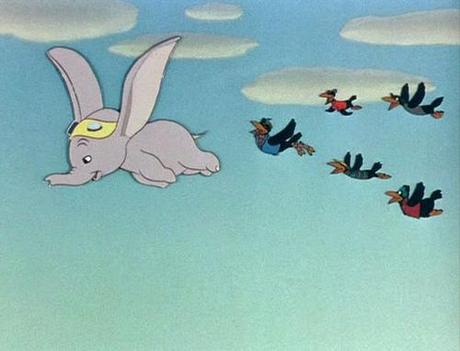
Dumbo no longer needs him. In effect, he has internalized the confidence that Timothy Mouse had given him.
Making it securely to Stage II obviously requires that Dumbo avoid regressing to Stage I, infancy. The conflict there is between trust and mistrust. This is the stage traditionally identified with orality, an identification that Erikson keeps. Dunking Dumbo in a tub of – let’s just call it that – milk, baby food, is a way of dramatizing the regressive danger he faces. For, that act was fabulously successful – for the clowns. Still, that act would have assured Dumbo a place in the circus if he’s willing to accept the humiliation that goes along with it.
But, in the end, Dumbo didn’t fall for the trap. But he had help, Timothy Mouse, who appeared in his life after his mother had been taken from him. Timothy Mouse is to Dumbo as Jiminy Cricket is to Pinocchio and, for that matter, as Gusteau is to Remy in Ratatouille. He is an aspect of himself that has been externalized as a separate being. The technical term for this is psychomachia, a well-known literary trope which I discuss in Ratatouille 4: Psychomachia Modern, with a Digression into Shakespeare.
Psychoanalytically, however, we can also see Timothy as a species of transition object, as the term has been defined by D. W. Winnicott, who sets things up by observing (Playing and Reality, p.1):
There is a wide variation to be found in a sequence of events that starts with the infant’s fist-in mouth activities, and leads eventually on to an attachment to a teddy, a doll or soft toy, or to a hard toy.Such objects function as transitional objects; while these objects are distinct from the infant, the infant does not quite treat them so. Timothy Mouse belongs to Dumbo, functions as a part of Dumbo, in that, once he meets him, he is Dumbo’s constant and faithful companion. But he acts as Dumbo’s mother would, encouraging him and protecting him.Of Regression and Disbelief
While psychoanalytic critics have made extensive use of Winnicott’s ideas, treating the work of art as itself a transitional object, I want to turn to another psychoanalytic theorist, Norman Holland, for some remarks on what Coleridge called “that willing suspension of disbelief for the moment, which constitutes poetic faith.” In an article published in 2003 (The Willing Suspension of Disbelief: A Neuro-Psychoanalytic View) Holland provides a neuro-psychoanalytic explication that turns on the fact that the nervous system is constantly projecting ahead, anticipating what we’ll see, touch, smell, and hear in the next few moments. To borrow a phrase from Andy Clark, the brain is a prediction machine.
Thus:
To intend to act, to plan a movement, we imagine the outcome. If I plan to move that glass of water on the table, I have to imagine where it is going to be after I have moved it. I have to imagine what is not now true–a contrafactual. I understand where the glass now is – the reality of the glass – by noting where it is not. Having moved the glass, I know where it is by remembering where it was, again something no longer the fact. We test reality by relating to it, by planning to move within it. And to move, we have to imagine a future and a past for an object, neither of which is true now. We test reality by imagining contrafactuals .. And as long as we do not plan to move while reading a book or watching a play or movie, we do not test the reality of what we are perceiving. Thus, we willingly suspend disbelief. The minute we do plan to move, we, as we say, break the spell. We are no longer rapt and absorbed. We restore what we are watching or reading to the real world in which we reality-test.By keeping our mind and senses active, but decoupling their activity from body movement, we enter into a specific behavioral mode (a term David Hays and I adopted from Warren McCulloch) that is structured to support aesthetic activity, in this case, story telling.
This mode doesn’t just happen. It is carefully cultivated from early childhood. Adults tell children stories in situations where they are safe; the child is free to believe in the story events, even dangerous and frightening ones, because she knows that she’s protected from harm. As Holland remarks:
In psychoanalytic terms, Coleridge's willing suspension of disbelief is a regression to an oral merger of infant and nurturing other in a potential space [that’s a term from Winnicott]. In neurological terms, we could say that regression means shutting down some “higher” system that modulates "lower" systems. In the case of the willing suspension of disbelief, the prefrontal cortex inhibits action and the planning of actions so that we no longer are aware of the unreality of the fictions we are dealing with, but it does not–cannot–inhibit the corticolimbic systems that give rise to our emotions. They run freely on, busily prompting us to actions, to approaches and avoidances, we never perform, but the psychological feelings and the physical signs of emotion persist.Here I think Holland misses a beat. I see no reason to assert that some “higher” system shuts down. Those higher systems are fully engaged with the fictional world, doing their best at predicting what will happen next–and, of course, getting it wrong as often as not. In dreaming, for example, motor areas of the brain are known to be quite active, but that activity is inhibited from reaching the muscles (alas, I have no citation headily at hand). That’s all we require, that the large muscles of the body be decoupled from the brain’s fantasy activity, whether in dreaming, reading a novel, or watching a movie.
Now let’s add Walter Freeman into the mix. Freeman is a neurobiologist at Berkeley who has devoted decades to understanding the medium and large-scale dynamics of neural nets. In Societies of Brains (1995) he draws implications for human behavior. His remarks on music (pp. 129-134). He is particularly interested in the music and dancing that accompanies social rituals, especially intense rituals involving hours of activity. He argues that during that intense activity neurotransmitters are released that tend to dissolve existing connections and thus allow new ones to form. Those new connections bond the participants to one another.
I am going to posit that something like that happens during all aesthetic activity (and perhaps even that it happens in proportion to our absorption into that activity, but I make no use of this elaboration in my argument). Which existing neural connections are dissolved? Why, some of those that are activated through the work of art. A connection must be active in order to be dissolved. It’s the work of art that drives neural activity while one is apprehending it. Which new connections are formed? Why, connections that are established while being absorbed in the work.
That is to say, during the period when the work of art is the main driver of neural activity, some connections will be weakened or dissolved all together while others are strengthened or even created anew. At the moment I can’t say any more than that. I regard that as a problem for a proper neuro-aesthetics, one that may emerge once investigators have tired of noting which patches of tissue seem to be most active when the mind is presented with this or that aesthetic object. And, to the extent that a work can remain active in the mind for some time after it is over, this neural shaping may even be influenced by discussions one has with friends and family.
This then is regression in service of the ego, a phrase coined by Ernst Kris to characterize the effect of a aesthetic experience. We enter into a specific behavioral mode in which complex and widespread patterns of neural connectivity are rewired under the “guidance” of a work of art. In this case, a feature-length cartoon, Dumbo.
So, Why the Milk?
There IS an obvious answer to that question in the “surface” of Dumbo, no need for psychoanalytic surfing in the “depths”. At that point in the film, when Dumbo is performing in the circus for the second time, he is made up as an infant. He’s wearing a baby bonnet, diaper, has a rattle in his trunk, and has white make-up on his face, accented by rouged spots on his cheeks. I’d say he was made up as a human infant except that the clown who is playing the role of his mother has a trunk on his mask. He’s made up as an elephant mother. Well, they’re neither elephants nor humans, but curious hybrid cartoon characters.
So, the obvious point of making the liquid white, like milk, is to underline Dumbo’s infantilization. Given that Dumbo is, in some obvious sense, an infant, we need to think about this.
In Dumbo’s first scene in the movie, he’s delivered by the stork and he does nothing other than look cute and reveal that he’s got those enormous ears. They are greeted with disapproval from his mother’s companions. In his second scene he’s helping to set up the tent, a scene that’s staged at night during a thunderstorm. He’s only marginally competent at this, but he’s clearly eager to pull his weight in the community. He wants to be a good citizen.
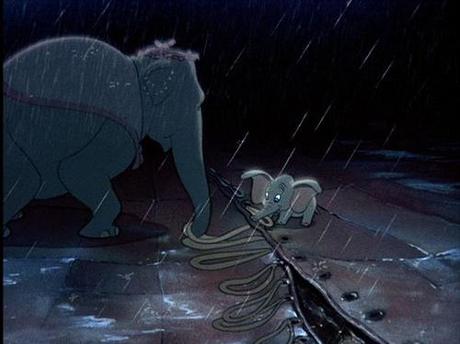
In his third scene he trips over his ears in a parade and stumbles in the mud. That leads immediately to his fourth scene, where his mother bathes him in a tub that is clearly filled with water. It’s much like the one he lands in at the end of his act.

They play around afterward:
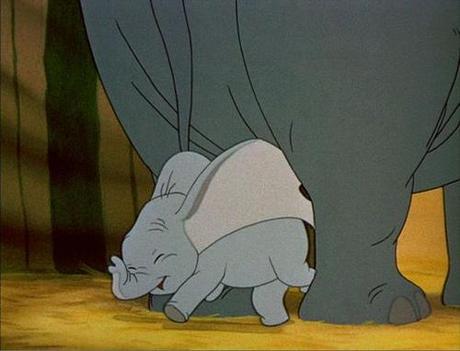
At this point the movie has strongly established that mother and son are close and that the son wants to be a productive member of the community.
It’s after this scene that disaster strikes. A kid visiting the circus harasses Young Dumbo and his mother moves to protect him. Panic ensues. Mrs. Jumbo is locked in a trailer away from Dumbo. He’s now separated from his mother and must fend for himself.
At this point Dumbo acquires a friend, a small mouse named Timothy, who provides Dumbo with comfort and encouragement and even a measure of protection: he scolds the elephant matrons who’d scorned Dumbo. He also comes up with an idea to make Dumbo a star, and cons the ringmaster into implementing that idea.
The elephants will form a pyramid, the world’s tallest pyramid of pachyderms, and Dumbo will then jump from a springboard and soar to the top. Alas, Dumbo trips over his ears on the run-up and crashes into the pyramid, bringing it down. And the falling elephants, in turn, bring down the tent.
Total disaster: Dumbo is formally ostrasized:
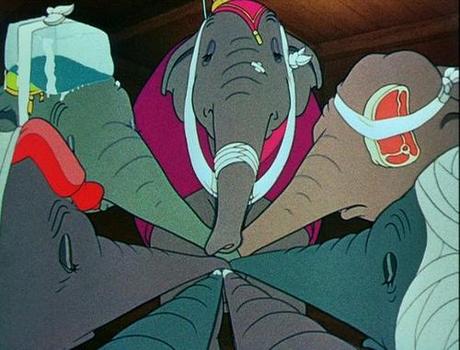
He no longer has a place in elephant society. He is socially dead. And so he must be socially reborn.
That process is given over to the clowns, who are, at best, marginal humans, so marginal that even the elephants treat them with disdain.
It’s worth noting that we never see the clowns except as clowns. We never see the men behind the make-up. To be sure, we see the clowns chatting after a performance. But the clowns are inside a tent and we’re outside the tent. We only see their silhouettes. Given that Disney was economizing on Dumbo (which was still rather lavish by contemporary standards), that may have been done to save money as it’s much easier to animate a flat figure with no internal detail than it is to animate a fully dimensional figure, not to mention the costs of inking and painting. If so, this bit of economy also serves a dramatic purpose, to emphasize the marginality of the clowns.
The clowns appropriate and restructure the act. Dumbo is still up high, but not atop a pyramid of elephants. Rather, he’s made-up as a baby and placed at the top of a burning building. Most of the clowns suit up as firemen who put out the fire and save the baby. We know how that works. Dumbo ends up drenched in white liquid: milk.
So, Dumbo’s first appearance in the ring is a total failure. This is also his first major action after having been forcibly separated from his mother. He’s acting on his own – well, not quite, because Timothy is advising and encouraging him – and he’s a failure. In his second appearance he’s infantilized and passive in a way we never saw with his mother before they were separated. That’s what Dumbo must overcome, infant helplessness.
From Hiccups to Bubbles
What happens next? Timothy takes him to visit his mother in her trailer. He may be doing this to assuage his sense of loneliness, but it is clear that he is as much a comfort to her as she is to him. Their caretaking is mutual. Both need to be cared for, and both need to be caring.
While he and Timothy are walking back to their quarters Timothy remarks: “What’s crying get you anyhow? Nothing but the hiccups.” At which point, wouldn’t you know it, Dumbo gets the hiccups. Hiccups are annoying. We’ve all had them and we all know how difficult it is to get rid of them. You can’t just will them away. And, at this point, will is very important in this film.
While Dumbo’s hiccupping they pass a water bucket, which one of the clowns had inadvertently spiked with liquor. They, of course, don’t know that. Dumbo drinks some water and Timothy orders him to hold it in – a well-known folk cure for the hiccups – which Dumbo does until he becomes red in the face. Timothy tells him to swallow it, he does. Alas, he has to hiccup again, blows bubble, lots of bubbles. The cure didn’t work.
Umm, err, may I interrupt?
Why sure, go ahead.
Why are you spelling out all this tedious detail? Can’t you just get on with it?
I’d love to, but the detail’s important. It’s about what Dumbo’s doing with his body and, by implication, what viewers are imagining in and on their own bodies.
You mean those mirror neurons?
Yes. More generally, we need to be aware of the fact works of art are exacting in their attention to detail. Even if we don’t quite know what to say about that detail, we should get used to attending to it. In time, when we’ve attended to enough patterns, we’ll begin to notice interesting similarities among these patterns.
And differences too?
Yes.
Oh, I see. Carry on.
What’s the point of holding in a hiccup and turning red in the face? Motor control. Hiccupping is involuntary. By holding it in, Dumbo is exhibiting motor mastery. Not only that, but it also demonstrates that he has a good working relationship with Timothy Mouse. They’re a team.
Timothy become curious about the water, falls in, drinks, becomes drunk, and starts hiccupping, giggling, and acting silly. Now they’re both drunk and Timothy is useless as a mentor.
Let me repeat that: At this point he’s friggin’ useless as a mentor. It’s all Dumbo his.own.bad.self at this point.
It’s in this drunken state the Dumbo discovers that he CAN do something. He can blow marvelous bubbles. Those bubbles had started as a side-effect of his hiccups; Dumbo no more intended to blow bubbles than he intended to hiccup. Dumbo now takes control over blowing those bubbles. After blowing several large enough to float Timothy in the air he blows one with a zigzag shape.
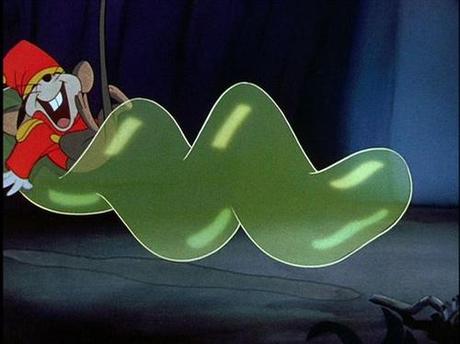
Timothy dares him to blow a “square one”. Remarkably enough Dumbo does so, though it requires elaborate contortions of his trunk (I really need a screen shot here but, alas, my screen shot utility doesn’t work with this computer). Then, again at Timothy’s urging, he blows a very large one. That bubble morphs into an elephant, which then blows another elephant, and so forth. That’s when the pink elephants take over the screen, with both Dumbo and Timothy watching them.
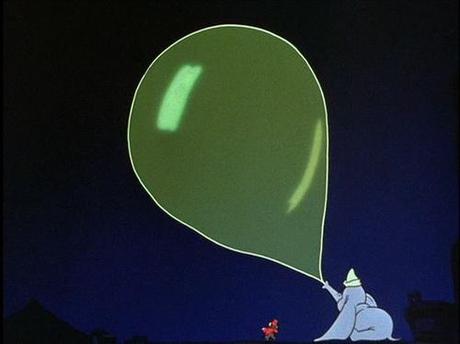
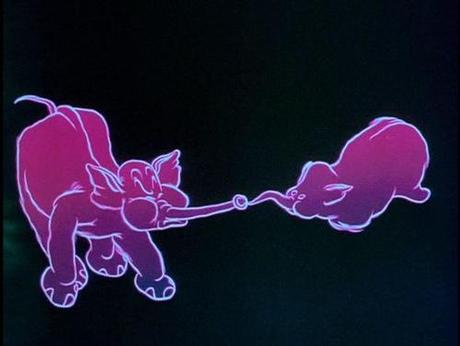
At this point it becomes obvious that, though he’s in an inebriated state, Dumbo is marvelous at something, and that something has to do with motor control over his body. Only a day or two before he couldn’t control his body well enough to leap to the top of a pyramid of elephants. Now, however, he’s blowing magnificent bubbles. He really IS good at something.
Pink Elephants on Parade
We now arrived at the Pink Elephants on Parade sequence, one of the major musical set pieces of the film. Given that we’re in a psychoanalytic frame of mind, we might be tempted to do what psychoanalytic critics do, and read that parade in terms of Dumbo’s psyche: What does it tell us about him?
I’m going to run it this from a different angle. What we see is that, without any action from Dumbo, indeed, much to Dumbo’s surprise, these elephants somehow create themselves out of one of his bubbles. He and Timothy (under the cap) are in the same position with respect to these elephants as we are:
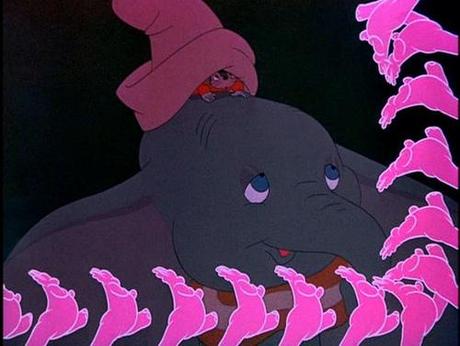
They’re spectators and so are we.
If we read getting drunk as oral regression, which is not unreasonable, then both Dumbo and Timothy have regressed at this point – and, remember, Timothy is functioning as a transition object mediating between Dumbo and his mother. Given the way things work out, we can see that, within the film itself, Dumbo has regressed in service of his further growth. In order to acquire a new psychological structure, the old one must be dissolved, and that’s going to leave you temporarily out of order.
At the same time, we the audience, we’ve regressed as well. We’re absorbed in the same images that have Dumbo’s attention, those pink elephants, their parade, and their other antics. Those pink elephants inhabit a potential space in which audience and Dumbo are, if not one and the same, absorbed by the same phenomena.
The whole sequence is worth our attention – see Secrets of Pink Elephants Revealed, Dumbo as Myth 2.2: Machines and Fordism, Animals in Cartoons : Tripping the Elephants Electric, and Electric Juice for Animals and Machines – but I want to select a few images from the middle of the sequence.
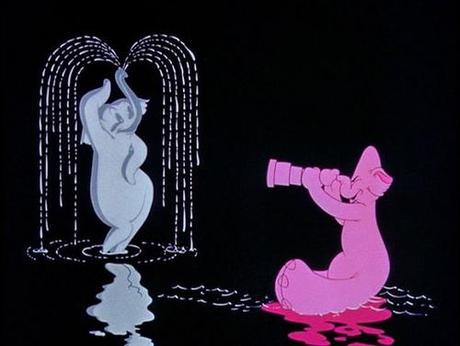


Here we see adult elephants involved in courtship behavior and in play – boating, ice skating, and dancing, to name a few. Those images probably have a different significance to us in the audience than they do to Dumbo. But in either case, these are clearly autonomous adults acting our their own lives. That’s what’s important.
Somewhere along in here Dumbo manages to fly up into a tree, but we don’t see that. All we see are those pink elephants. Once he gets there, well, we in the audience grasp the implications quite quickly, as do the crows. But that takes Dumbo while, and it requires trust: he must trust the crows, Timothy, and his own reason (“how else could I have gotten up here?”).
He does so, and the movie has a happy ending. Dumbo triumphs in his third appearance in the circus. The act is ostensibly the one the clowns created around him, this time with the burning tower much higher. Rather then simply falling into the tub of milk Dumbo uses his ears to bring him out of the dive and then flies triumphantly around the big top. He chases the clowns and the ringmaster in to tubs of water and pelts the elephant matrons with peanuts he shoots out through his trunk. But that’s the extent of his revenge. His mother is released from captivity and given a place of honor in a sleek modern caboose at the end of the train.
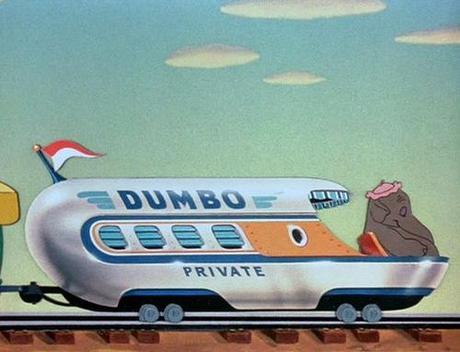
Where Are We?
The point of this post is to demonstrate that psychoanalytic ideas remain useful in this new millennium, a bit more than a century after Freud began publishing them.
If you began reading this piece as a skeptic and remain skeptical, well, I’m not surprised. I would hardly expect this one blog post to convince you to re-consider, but you do have to think about the specific aspects of Dumbo that prompted this post: 1) the fact the Dumbo lands in a tub of milk rather than water, and 2) the existence of the pink elephants episode.
My argument has been this: those things are not accidents. They are deliberate. How can we explain them? If you don’t like my psychoanalytic explanation, what alternative can you offer? If you have no alternative ready, do you have some notion of how one might be created? If not, are you going, instead, to argue that there’s nothing to be explained about that tub of milk or those elephants. In effect, they’re there because they’re there and art is crazy and anyhow it’s only a cartoon.
You lose. You have, in effect, said that human behavior is unintelligible. Perhaps you don’t think that’s what you’ve said; perhaps you only mean to dismiss art. It won’t work. If you dismiss art as unintelligible, then you’ve pretty much dismissed human behavior in general. But I suppose I must provide an argument for those assertions, and that argument would go well beyond the bounds of this post.
Let this be the last line.

